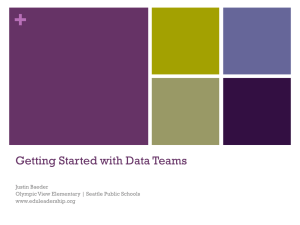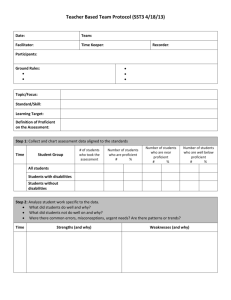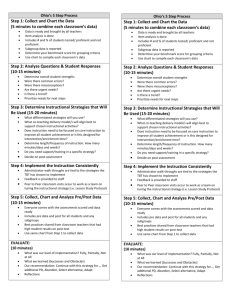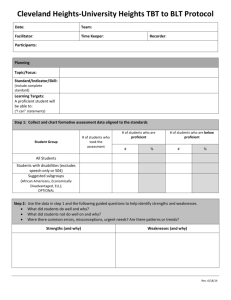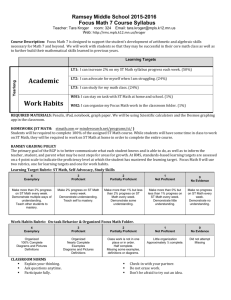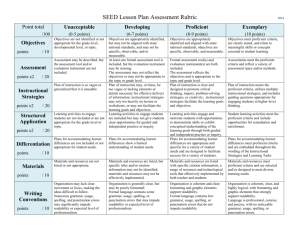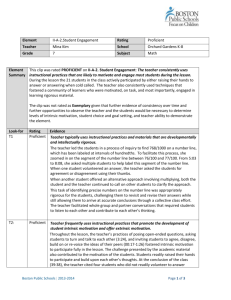Data Team Process: 6 Steps to Improve Student Learning
advertisement
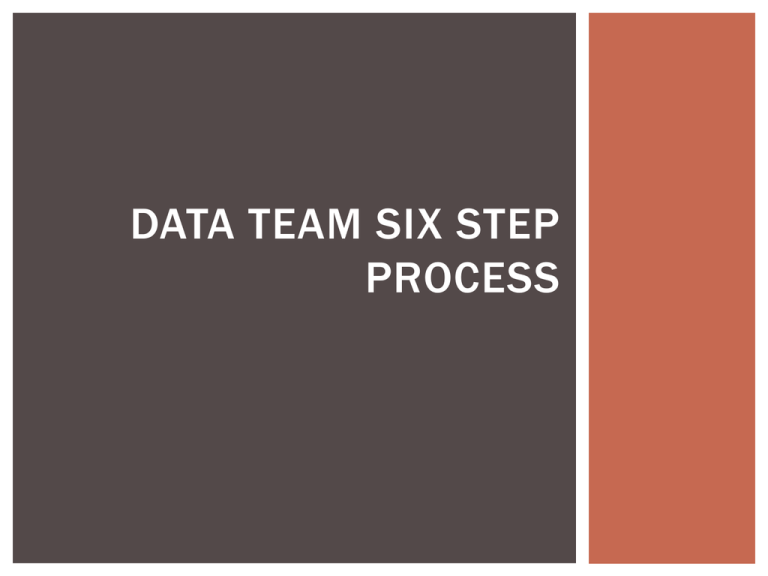
DATA TEAM SIX STEP PROCESS GOAL: IMPROVED TEACHING AND STUDENT LEARNING Analyze student performance in context with school, district and state performance Implement the plans and evaluate the outcomes of implementation Select strategies, develop plans to implement strategies, and plans to evaluate implementation and results of strategies Analyze student performance to determine learning needs Determine and prioritize focus areas (goals) for improvement Review research based strategies for addressing focus areas FOCUSED ON FOUR CRITICAL QUESTIONS 1. What do we expect students to learn? 2. How will we know when they learn it? 3. How will we respond when students have difficulty learning it? 4. How will we respond when students do learn? DATA TEAM PROCESS 1. Collect and chart data 2. Analyze strengths and obstacles 3. Establish goals: set, review, revise 4. Select instructional strategies 5. Determine results indicators 6. Monitor results STEP 1: COLLECT AND CHART DATA 1 . C o l l ec t , a n a l y z e , a n d c h a r t d a t a to d ete r m i n e s t u d e n t s w h o a r e n o t yet p r o f i ci e n t Students Tested Teacher Names LEVEL Proficient or Exemplary Proficient after Instruction Additional Time / Opportunity Total Number and Names of Students who are Proficient or Exemplary Total Number and Names of Students who will be Proficient after Instruction Total Number and Names of Students in need of Additional Time/Opportunity Extensive Intervention Total Number and names of Students in Need of Extensive Intervention STEP 2: ANALYZE STRENGTHS AND OBSTACLES 2. Examine student work on pre/post test to identify strengths and obstacles. Student Performance Strengths: * * * * Prioritized Needs: 1. 2. 3. 4. 5. Obstacles: * * * * STEP 3: ESTABLISH GOALS: SET, REVIEW, REVISE 3. Establish goals: set, review, revise Percentage of __________________ scoring proficient and higher in ____________________________ will increase from _____% to _____% by _________as measured by the _________________ Post Test. Standards Addressed : Priority Standards: Supporting Standards: STEP 4: SELECT INSTRUCTIONAL STRATEGIES 4. Select Instructional Strategies Identified Need: Brainstorm List of Effective Strategies 1. 2. 3. 4. 5. Selected Instructional Strategy (Determined through unit/lesson design to provide focused, first-best instruction) Learning Environment (Small group, whole group, place, etc.) Time – Duration of the Teaching of Specific Concepts and/or Skills Materials for Teachers and Students Assignments, Assessments – Where will students be required to use the strategy? How will we differentiate instruction? Intensive (Developed in collaboration with Special Education and ELL Specialists) Targeted (Aligned with “double-dose” interventions, partnerships with parents, and tutors) Extended (Supporting students proficient in the area being focused on) STEP 5: DETERMINE RESULTS INDICATORS 5. Determine Results Indicators: Identified Need: Selected Strategy: Result Indicators: Adult Behaviors: If we use this strategy… Student Behaviors: then we can expect… Look-fors in Student Work: STEP 6: MONITOR RESULTS 6. Monitor your results Data you plan to monitor Monitoring Strategies What will I do and what will I bring to next meeting? Timeline of Instructional Period Evaluate: (Compare planned against achieved results; Summarize impressions, recall supporting information, compare, contrast, analyze, infer, and determine the potential cause-and-effect relationships) We planned these…(goals, results indicators) We achieved these…(goals, results indicators) Applying: (Construct new learnings and applications) We learned… We will replicate... REVIEW THE CYCLE Analyze student performance in context with school, district and state performance Implement the plans and evaluate the outcomes of implementation Select strategies, develop plans to implement strategies, and plans to evaluate implementation and results of strategies Analyze student performance to determine learning needs Determine and prioritize focus areas (goals) for improvement Review research based strategies for addressing focus areas
